Arm Announces New Mali-G710, G610, G510 & G310 Mobile GPU Families
by Andrei Frumusanu on May 25, 2021 10:00 AM ESTThe Mali-G510 & G310: Attacking the low-end
In the mid-range, the new Mali-G510 and Mali-G310 are generational improvements over the market predecessors, the G57 and G31. Representing new major jumps in the microarchitectures, these new designs are unnaturally large performance jumps for Arm’s mid-range and low-end offerings.
From a very high view, the G510 scales up from 2 cores to 6 cores, but offers differentiation through changing the number of clusters within one of the execution units per core, or also changing the type of texture units in use, either a 4x throughput unit, or an 8x unit.
On the execution engine side, we always have two execution engines, but it’s possible to configure down one of them to only contain a single cluster, effectively reducing the compute part of the core from a 64 FMA/cycle design to a 48 FMA/cycle design. The reason for such granularity is that the usual customers for such GPUs have hyper-optimised use-cases and will configure their GPU implementation for a specific use-case and criteria, and only use the bare minimum configuration to fulfil those demands, in the smallest possible area.
Arm here puts an emphasis on the 10 different configuration options of the G510 IP, all having different compute or fill rate optimised performance points. It might be quite a bit unintuitive for the every-day reader to understand the need for such configurability, but there are non-mobile markets which really care about every fraction of a mm² when it comes to implementations.
Scaling further below the G510 is the new G310. This GPU is actually a major performance leap compared to the previous generation smallest Mali IP offering, the G31, as we’re seeing the move from a Bifrost architecture to the new Valhall design.
Here, we’re seeing adoption of the new execution engine design, but allowing to further scale down the clusters to only one per EE, and also allowing only one EE in the minimum configuration, allowing scaling of 16, 32, 48 or 64 FMA per shader core. The texture units also scale down to 2 texels/cycle units at minimum, and also seeing a varying unit that’s scaled down compared to its bigger siblings.
The G310 is exclusively a single shader core design, so the configurations are exclusively achieved through changing the different execution units within that core. Unfortunately Arm doesn’t seem to plan out any public naming scheme for the various configurations, so it will be all up to the vendors to actually do any kind of disclosure.


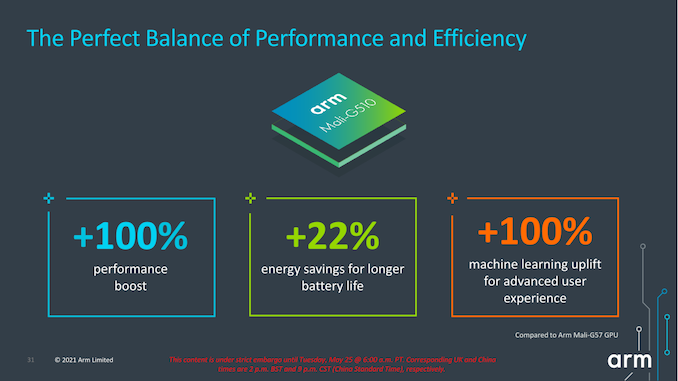
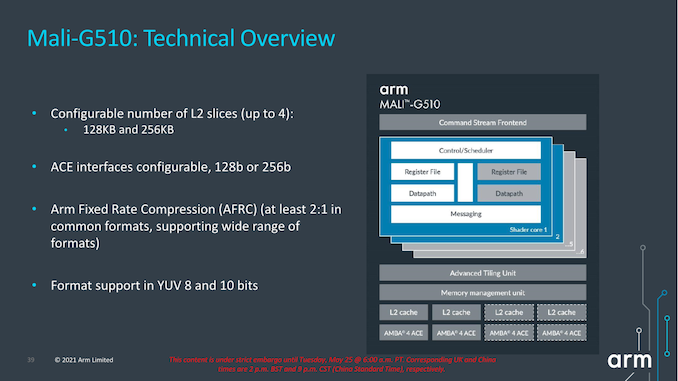
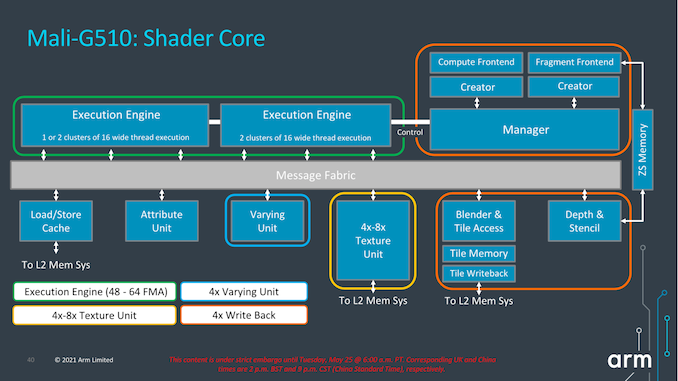
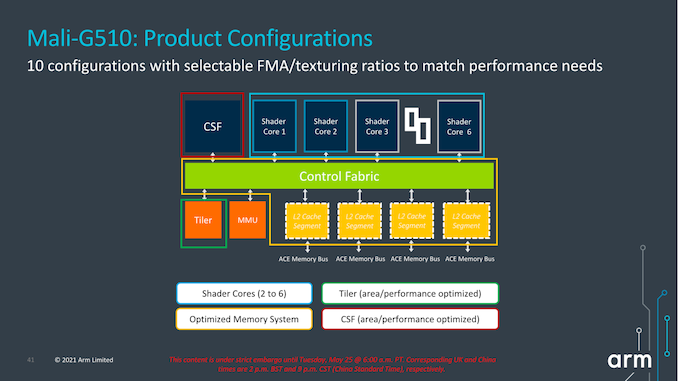
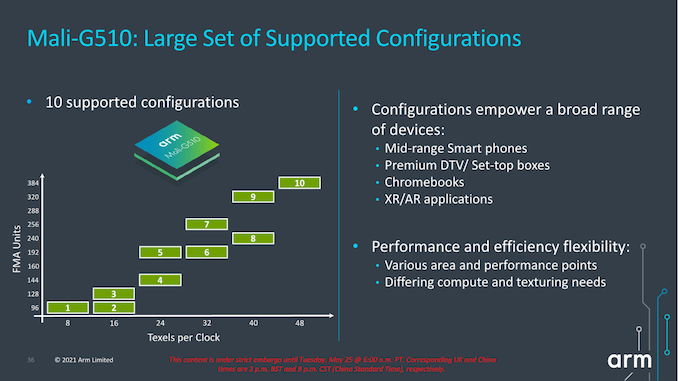
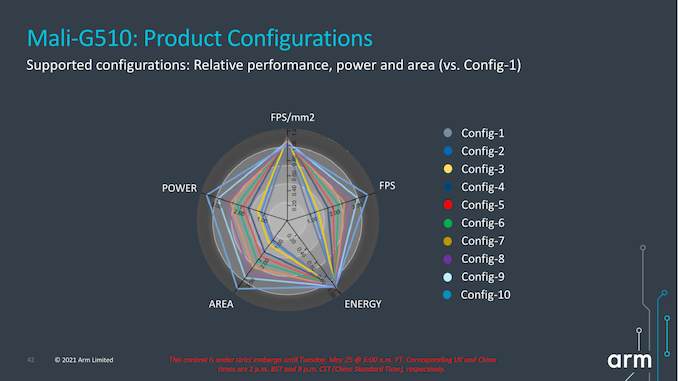
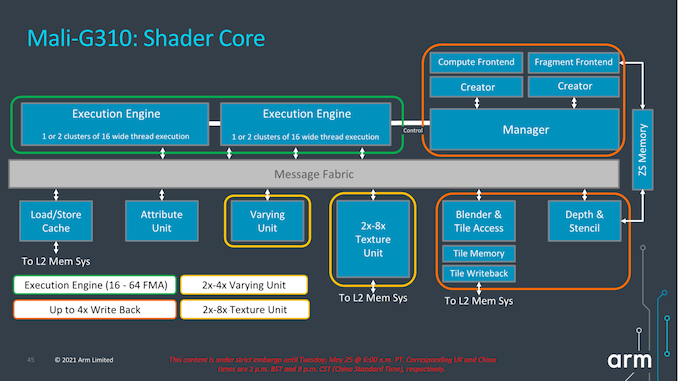
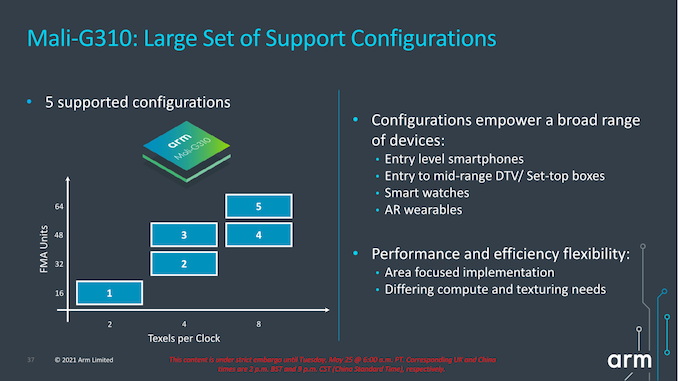








30 Comments
View All Comments
ForNein - Tuesday, May 25, 2021 - link
Which Mali gpu is Google's Whitechapel going to have? I suspect it will be something older and unimpressive.EthiaW - Tuesday, May 25, 2021 - link
Google has floudered in its every hardware project, don't hold expectation in them friend.Kangal - Thursday, May 27, 2021 - link
They're somewhat incompetent in software too. Heaps of easy and obvious bugs in every platform in every update... at least when compared to their competitors. Also their biggest successes were projects that was kickstarted externally, and simply acquired.Do they have poor QA Department or something?
Or maybe it's just they have some of the worst management team in the world, where they release half-finished projects to the world, only to double-back and kill them off in a small timeframe.
Spunjji - Friday, May 28, 2021 - link
Their internal structure rewards doing novel things, not sustained success.Fulljack - Wednesday, May 26, 2021 - link
probably last year's G78, but it's also possible to use this new G710.tuxRoller - Thursday, May 27, 2021 - link
According to xda (https://www.xda-developers.com/google-pixel-6-same... it looks to be G78.SarahKerrigan - Tuesday, May 25, 2021 - link
"The only other surviving GPU IP vendor"This is not accurate. Think Silicon is one exception; Verisilicon, which inherited the Vivante product family, is arguably another, though it hasn't seen much movement since the GC8k came out.
Infy2 - Tuesday, May 25, 2021 - link
No ray tracing support? Boo!Wereweeb - Wednesday, May 26, 2021 - link
If you want a frying pan functionality, just ask.Spunjji - Friday, May 28, 2021 - link
ARM have a primary focus on area efficiency, spending area on RT features that are too slow to use would not be a good decision for them.